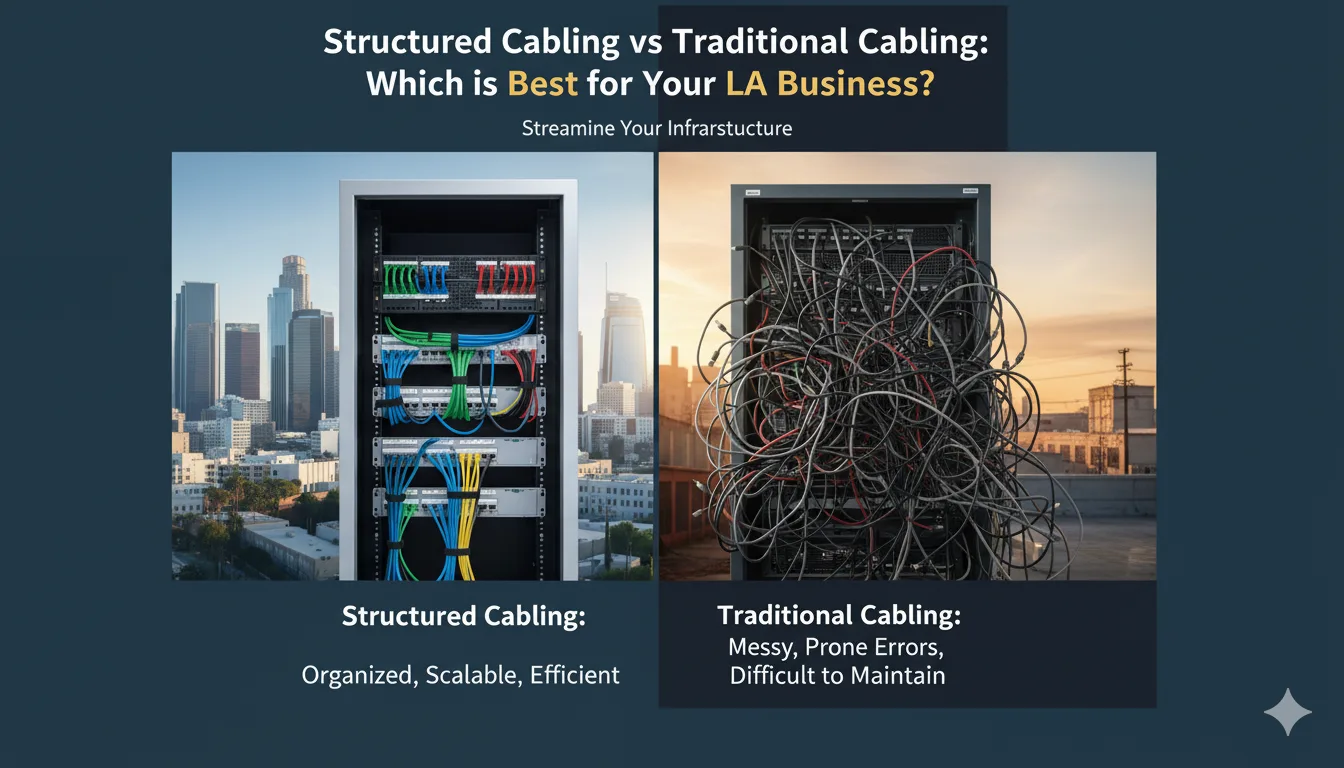Connectivity and communication in today’s business environment is of utmost importance, so designing the infrastructure of an office or commercial space requires two main choices for cabling infrastructure, the one is Structured cabling and traditional cabling is the 2nd one. But which option best meets the needs of your organization? Here we explore their differences as well as why FDS Network Services, an established surveillance and network provider in Los Angeles, recommends structured cabling over traditional cabling for modern businesses. In this blog we do a fair comparison of Structured cabling vs traditional cabling.
What is Structured Cabling?
Structured cabling refers to a standardized cabling system designed for telecom and data transfer. This versatile approach combines voice, data, and video communications by means of network services for voicemail systems or security cameras when necessary. Its growing popularity reflects the fact that over time cabling is inexpensive to install, saves money, and needs less maintenance than copper wiring or wireless systems.
What is Traditional Cabling?
Traditional cabling refers to older, non-standardized systems used for network connectivity. With traditional cabling systems, each device or system must be wired individually so there is no unified or standard framework; making traditional cabling less flexible and harder to scale than its more modern counterpart. Businesses depending on conventional cabling systems sometimes run into problems as several cables and connectors have to support equipment from different categories. Managing these arrangements grows progressively more difficult as networks grow, which results in lower uptime, slower speeds, and higher maintenance costs.
Structured Cabling vs. Traditional Cabling: Key Differences
| features | Structured cabling | Traditional cabling |
| organization | Organized, centralized framework | Disorganised wires |
| scalability | Easy upgrade with business growth | Require complete overhauls |
| flexibility | Support a variety of device | Limited to network types |
| maintenance | Easy troubleshooting, maintenance | Complex and time consuming |
| Installation cost | Initial high cost, cost effective | Initial cost low but higher in long term |
| Reliability | Highly reliable | Prone to failure |
| Modifications | Simple to modify | Difficult to modify |
| longevity | Long term solution | Short life span |
| Future proofing | Easy to handle Future | May not support Future advancement |
Why Structured Cabling is Ideal for Your LA Business
- Long-term Investment: While there is an upfront cost associated with structured cabling, its long-term advantages much surpass this factor. As your business spreads out you will need a well-organized system that fulfils the demands of growing business. So here in this aspect the debate of structured cabling vs traditional cabling tilt towards structured cabling.
- Less Downtime: After introducing the high quality structured cabling the technicians fix problems immediately and make repairs more efficiently, companies that rely on connectivity for daily operations will experience less downtime.
- Future-Proofing: Structured cabling was meant to fit new technology. More information and equipment could have to be maintained on your LA company’s network as it grows; using structured cabling will ensure you are ready and free from having to totally rebuild its infrastructure.
- Easy Network Management: For companies using several surveillance cameras, smart devices, or linked systems for monitoring reasons, structured cabling makes network management easier and more organized. Companies using many surveillance cameras or connected systems in their activities can especially find this feature helpful.
- Cost-Efficient in the Long Run: While traditional cabling might appear cheaper up-front, its maintenance costs
Conclusion
Take some time to decide between conventional cabling and structured cabling for your company in Los Angeles. Because better networks enhance your performance and dependability. For smaller projects with few use cases, conventional traditional cabling might be sufficient; however, for bigger-scale corporate applications requiring flexibility, scalability, and long-term dependability from their network infrastructure solutions. FDS company is an expert in providing network solutions and top-notch surveillance. Get in touch if you are ready to switch and maximize it for growth. Call us now to arrange a meeting and install the structured cabling for the betterment of the company in Los Angeles.
FAQs
Question: What is structured cabling?
Answer: Structured cabling is a standardized system designed to support telecom, data, voice, and video communications through an organized network infrastructure.
Question: How does traditional cabling differ?
Answer: Traditional cabling uses non-standardized wiring where each device is wired separately, leading to disorganization and less flexibility.
Question: Why choose structured cabling for my LA business?
Answer: It offers scalability, easy maintenance, less downtime, and future-proofing, making it ideal for growing businesses.
Question: Is structured cabling expensive?
Answer: It has a higher initial cost but saves money long-term through reduced maintenance and upgrades.
Question: Can structured cabling support future technologies?
Answer: Yes, it is designed to accommodate future advancements easily.
Question: How does structured cabling affect network management?
Answer: It simplifies managing multiple devices and surveillance systems through a centralized framework.
Question: When is traditional cabling suitable?
Answer: For smaller projects with limited networking needs, traditional cabling may suffice.




